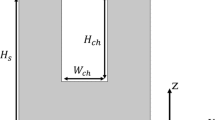Abstract
In industrial fields of machine and aerospace, cooling systems consisting of channels are widely used to increase energy efficiency and prevent system overheat. In cooling channels, a reduced pressure drop, an enhanced heat transfer, and a short channel length are considered key design requirements for optimizing the total volume and weight of a system. In this work, we improved heat transfer efficiency by using milli-scale wavy structures inside the channel. By optimizing the inner structures through computational fluid dynamics analysis and Taguchi method, the Nusselt number increased by approximately 11.7% with a similar pressure drop compared with that of a normal channel for a Reynolds number of 1000.
Similar content being viewed by others
References
R. E. Mayle, The role of laminar-turbulent transition in gas turbine engines, ASME Journal of Turbomachinery, 113 (1991) 509–537.
D. E. Metzger, Fundamental heat transfer research for gas turbine engines, Scientific and Technical Information Office, NASA, USA (1980).
R. J. Goldstein, Film cooling, Advances in Heat Transfer, 7 (1971) 272–328.
R. J. Goldstein, R. G. Eckert and F. Burggraf, Effects of hole geometry and density on three-dimensional film cooling, International Journal of Heat & Mass Transfer, 17 (1974) 595–607.
B. Bhandari, K.-T. Lee, G.-Y. Lee, Y.-M. Cho and S.-H. Ahn, Optimization of hybrid renewable energy power systems: A review, International Journal of Precision Engineering and Manufacturing-Green Technology, 2 (1) (2015) 99–112.
J. P. Farmer, D. J. Seager and J. A. Libury, The effect of shaping inclined slots on film cooling effectiveness and heat transfer coefficient, ASME Int. Gas Turbine and Aeroengine Congress and Exhibition, Orlando, Florida, USA (1997) 1–8.
J. Andreopoulos, Measurements in a jet-pipe flow issuing perpendicularly into a cross stream, ASME Journal of Fluids Engineering, 104 (1982) 493–499.
S. Lloyd and A. Brown, Velocity and turbulence fields in pipe entrance regions in the presence of cross flows, ASME Journal of Engineering for Gas Turbines and Power, 108 (1986) 499–503.
E. R. G. Eckert, Similarity analysis of model experiments for film cooling in gas turbines, Wärme-und Stoffübertragung, 27 (1992) 217–223.
S. Honami, T. Shizawa and A. Uchiyama, Behavior of the laterally injected jet in film cooling: measurements of surface temperature and velocity/ temperature field within the jet, Journal of Turbomachinery, 116 (1994) 106–112.
I. S. Jung and J. S. Lee, Effects of orientation angles on film cooling over a flat plate: boundary layer temperature distributions and adiabatic film cooling effectiveness, Journal of Turbomachinery, 122 (2000) 153–160.
R. J. Goldstein and P. Jin, Film cooling downstream of a row of discrete holes with compound angle, Journal of Turbomachinery, 123 (2001) 222–230.
R. Hölker, A. Jäger, N. B. Khalifa and A. E. Tekkaya, Controlling heat balance in hot aluminum extrusion by additive manufactured extrusion dies with conformal cooling channels, International Journal of Precision Engineering and Manufacturing, 14 (8) (2013) 1487–1493.
C.-H. Song, K.-B. Kwon, J.-Y. Park, J.-Y. Oh, S. Lee, D.-Y. Shin and J.-W. Cho, Optimum design of the internal flushing channel of a drill bit using RSM and CFD simulation, International Journal of Precision Engineering and Manufacturing, 15 (6) (2014) 1041–1050.
D. H. Rhee, Y. S. Lee and H. H. Cho, Film cooling effectiveness and heat transfer of rectangular-shaped film cooling holes, ASME Turbo Expo 2002: Power for Land, Sea, and Air, Amsterdam, The Netherlands (2002) 21–32.
B. Sunden and G. Xie, Gas turbine blade tip heat transfer and cooling: a literature survey, Heat Transfer Engineering, 31 (7) (2010) 527–554.
Y. C. Lin, F. P. Chuang, A. C. Wang and H. M. Chow, Machining characteristics of hybrid EDM with ultrasonic vibration and assisted magnetic force, International Journal of Precision Engineering and Manufacturing, 15 (6) (2014) 1143–1149.
P.-C. Chen, Y.-C. Chen, C.-W. Pan and K.-M. Li, Parameter optimization of micromilling brass mold inserts for microchannels with Taguchi method, International Journal of Precision Engineering and Manufacturing, 16 (4) (2015) 647–651.
F. P. Incropera, D. P. DeWitt, T. L. Bergman and A. S. Lavine, Introduction to Heat Transfer, 5th ed, John Wiley & Sons, Inc., Notre Dame (2007).
Z. Yang and T. H. Shih, New time scale based k-epsilon model for near-wall turbulence, AIAA Journal, 31 (7) (1993) 1191–1198.
F. W. Dittus and L. M. K. Boelter, Heat transfer in automobile radiator of the tubular type, UC Berkley Publisher, Engineering, 2 (1930) 443–461.
Author information
Authors and Affiliations
Corresponding author
Additional information
Recommended by Editor Haedo Jeong
Ju-Chul Lee earned his B.S. (2010) and M.S. (2014) at School of Mechanical Engineering in Pusan National University. His research topics were a vibration induced EDM process and cooling channel design. Presently, he is the CEO of a turbomachinery company.
Sang-Hu Park is a professor of Mechanical Engineering at Pusan National University, since 2007. He earned his B.S. at Pusan National University (1994), M.S. and Ph.D. in Mechanical Engineering, at Korea Advanced Institute of Science and Technology (KAIST, Korea) in 1996 and 2006, respectively. His research fields are development of 3D printing process, Nanofabrication, Mechanical design and manufacturing technology, especially for multi-scale structures.
Rights and permissions
About this article
Cite this article
Lee, JC., Park, SH., Son, C. et al. Numerical study on the thermal and flow characteristics of periodically formed inner wavy structures in a cooling channel. J Mech Sci Technol 29, 3911–3917 (2015). https://doi.org/10.1007/s12206-015-0837-z
Received:
Revised:
Accepted:
Published:
Issue Date:
DOI: https://doi.org/10.1007/s12206-015-0837-z




